YEALINK T21P User Manual

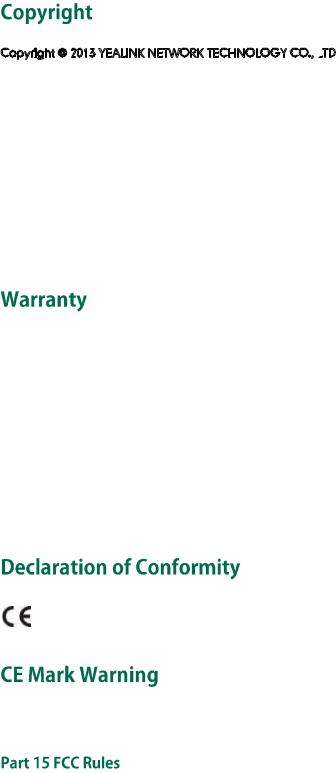
Copyright © 2013 YEALINK NETWORK TECHNOLOGY CO., LTD

Copyright © 2013 Yealink Network Technology CO., LTD. All rights reserved. No parts of this publication may be reproduced or transmitted in any form or by any means, electronic or mechanical, photocopying, recording, or otherwise, for any purpose, without the express written permission of Yealink Network Technology CO., LTD. Under the law, reproducing includes translating into another language or format.
When this publication is made available on media, Yealink Network Technology CO., LTD. gives its consent to downloading and printing copies of the content provided in this file only for private use but not for redistribution. No parts of this publication may be subject to alteration, modification or commercial use. Yealink Network Technology CO., LTD. will not be liable for any damages arising from use of an illegally modified or altered publication.
THE SPECIFICATIONS AND INFORMATION REGARDING THE PRODUCTS IN THIS GUIDE ARE SUBJECT TO CHANGE WITHOUT NOTICE. ALL STATEMENTS, INFORMATION, AND RECOMMENDATIONS IN THIS GUIDE ARE BELIEVED TO BE ACCURATE AND PRESENTED WITHOUT WARRANTY OF ANY KIND, EXPRESS OR IMPLIED. USERS MUST TAKE FULL RESPONSIBILITY FOR THEIR APPLICATION OF PRODUCTS.
YEALINK NETWORK TECHNOLOGY CO., LTD. MAKES NO WARRANTY OF ANY KIND WITH REGARD TO THIS GUIDE, INCLUDING, BUT NOT LIMITED TO, THE IMPLIED WARRANTIES OF MERCHANTABILITY AND FITNESS FOR A PARTICULAR PURPOSE. Yealink Network Technology CO., LTD. shall not be liable for errors contained herein nor for incidental or consequential damages in connection with the furnishing, performance, or use of this guide.
Hereby, Yealink Network Technology CO., LTD. declares that this phone is in conformity with the essential requirements and other relevant provisions of the CE, FCC.
This device is marked with the CE mark in compliance with EC Directives 2006/95/EC and 2004/108/EC.
This device is compliant with Part 15 of the FCC Rules. Operation is subject to the following two conditions:
1.This device may not cause harmful interference, and
2.This device must accept any interference received, including interference that may cause undesired operation.
ii
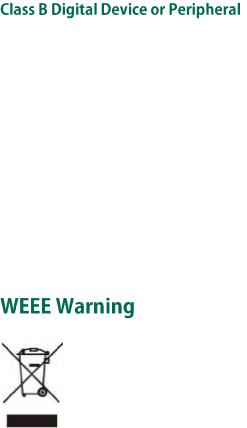
. Changes or modifications not expressly approved by the party responsible for compliance could void the user’s authority to operate the equipment.
Note: This device is tested and complies with the limits for a Class B digital device, pursuant to Part 15 of the FCC Rules. These limits are designed to provide reasonable protection against harmful interference in a residential installation. This equipment generates, uses, and can radiate radio frequency energy and, if not installed and used in accordance with the instructions, may cause harmful interference to radio communications. However, there is no guarantee that interference will not occur in a particular installation. If this equipment does cause harmful interference to radio or television reception, which can be determined by turning the equipment off and on, the user is encouraged to try to correct the interference by one or more of the following measures:
1.Reorient or relocate the receiving antenna.
2.Increase the separation between the equipment and receiver.
3.Connect the equipment into an outlet on a circuit different from that to which the receiver is connected.
4.Consult the dealer or an experience radio/TV technician for help.
To avoid the potential effects on the environment and human health as a result of the presence of hazardous substances in electrical and electronic equipment, end users of electrical and electronic equipment should understand the meaning of the crossed-out wheeled bin symbol. Do not dispose of WEEE as unsorted municipal waste and have to collect such WEEE separately.
iii

Yealink SIP-T21P firmware contains third-party software under the GNU General Public License (GPL). Yealink uses software under the specific terms of the GPL. Please refer to the GPL for the exact terms and conditions of the license.
The original GPL license, source code of components licensed under GPL and used in Yealink products can be downloaded online: http://www.yealink.com/GPLOpenSource.aspx?BaseInfoCateId=293&NewsCateId=293&CateId=293.
iv
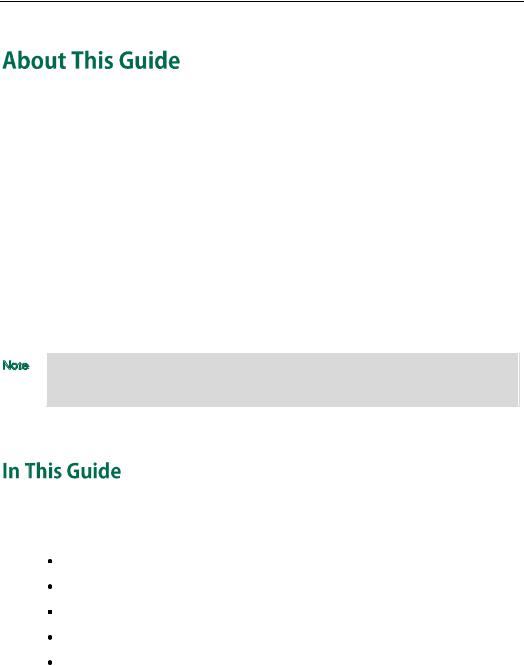
About This Guide
Thank you for choosing the SIP-T21P IP phone, exquisitely designed to provide business telephony features, such as Call Hold, Call Transfer, Busy Lamp Field, Multicast Paging and Conference over an IP network.
This guide provides everything you need to quickly use your new phone. First, verify with your system administrator that the IP network is ready for phone configuration. Also be sure to read the Packaging Contents and Regulatory Notices sections in this guide before you set up and use the SIP-T21P IP phone.
If this is your first time using the SIP-T21P IP phone, we recommend that you first refer to the 









 and
and 








 , available online: http://www.yealink.com/DocumentDownload.aspx?CateId=142&flag=142.
, available online: http://www.yealink.com/DocumentDownload.aspx?CateId=142&flag=142.
Note Shared Line, Busy Lamp Field List, Network Directory and Network Call Log features are hidden for IP phones in neutral version, which are designed for BroadWorks environment. Please contact your system administrator for more information.
This is the first edition based on firmware version 71. Topics provided in this guide include:
Chapter 1 Overview
Chapter 2 Getting Started
Chapter 3 Customizing Your Phone
Chapter 4 Basic Call Features
Chapter 5 Advanced Phone Features
v

User Guide for the SIP-T21P IP Phone
vi
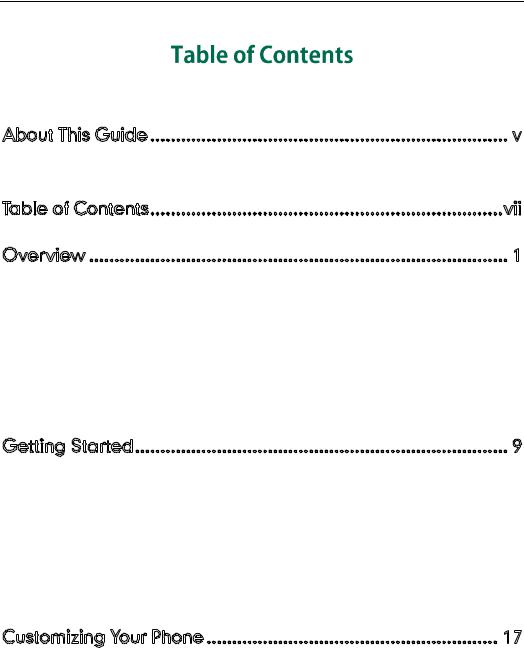
Table of Contents
About This Guide ...................................................................... |
v |
In This Guide ......................................................................................................................... |
v |
Table of Contents..................................................................... |
vii |
Overview .................................................................................. |
1 |
Hardware Component Instructions.................................................................................... |
1 |
Icon Instructions.................................................................................................................... |
3 |
LED Instructions..................................................................................................................... |
4 |
User Interfaces ..................................................................................................................... |
5 |
Phone User Interface........................................................................................................ |
5 |
Web User Interface........................................................................................................... |
5 |
Documentations ................................................................................................................... |
8 |
Getting Started......................................................................... |
9 |
Packaging Contents............................................................................................................. |
9 |
Phone Installation............................................................................................................... |
11 |
Phone Initialization............................................................................................................. |
13 |
Phone Status ....................................................................................................................... |
13 |
Basic Network Settings...................................................................................................... |
14 |
Registration ......................................................................................................................... |
16 |
Idle Screen.......................................................................................................................... |
16 |
Customizing Your Phone ......................................................... |
17 |
General Settings ................................................................................................................ |
17 |
Contrast............................................................................................................................ |
17 |
Language......................................................................................................................... |
18 |
Time & Date ..................................................................................................................... |
19 |
Administrator Password ................................................................................................. |
20 |
Key as Send..................................................................................................................... |
21 |
Keypad Lock.................................................................................................................... |
21 |
Audio Settings .................................................................................................................... |
24 |
Volume ............................................................................................................................. |
24 |
Ring Tones........................................................................................................................ |
25 |
Contact Management....................................................................................................... |
27 |
Directory........................................................................................................................... |
27 |
|
vii |

User Guide for the SIP-T21P IP Phone
Local Directory ................................................................................................................ |
28 |
Blacklist ............................................................................................................................ |
38 |
Remote Phone Book........................................................................................................ |
40 |
Call History Management ................................................................................................ |
42 |
System Customizations...................................................................................................... |
44 |
Logo Customization ........................................................................................................ |
44 |
Headset Use.................................................................................................................... |
45 |
DSS Keys .......................................................................................................................... |
46 |
Account Management ................................................................................................... |
54 |
Dial Plan ........................................................................................................................... |
55 |
Emergency Number........................................................................................................ |
61 |
Live Dialpad .................................................................................................................... |
62 |
Hotline .............................................................................................................................. |
63 |
Basic Call Features................................................................. |
65 |
Placing Calls ....................................................................................................................... |
65 |
Answering Calls ................................................................................................................. |
67 |
Ending Calls........................................................................................................................ |
68 |
Redialing Numbers ............................................................................................................ |
69 |
Recent Call In Dialing ........................................................................................................ |
69 |
Auto Answer ....................................................................................................................... |
70 |
Auto Redial.......................................................................................................................... |
71 |
Call Completion ................................................................................................................. |
72 |
Call Return........................................................................................................................... |
73 |
Call Mute............................................................................................................................. |
73 |
Call Hold/Resume............................................................................................................... |
74 |
Do Not Disturb (DND) ........................................................................................................ |
75 |
Call Forward ....................................................................................................................... |
78 |
Call Transfer ........................................................................................................................ |
84 |
Call Waiting ........................................................................................................................ |
86 |
Conference ......................................................................................................................... |
86 |
Local Conference............................................................................................................ |
87 |
Network Conference ...................................................................................................... |
87 |
Call Park .............................................................................................................................. |
89 |
Call Pickup .......................................................................................................................... |
90 |
Anonymous Call ................................................................................................................. |
95 |
Anonymous Call Rejection ................................................................................................ |
96 |
Advanced Phone Features..................................................... |
97 |
Busy Lamp Field (BLF) ....................................................................................................... |
97 |
Call Recording .................................................................................................................... |
99 |
Hot Desking ...................................................................................................................... |
101 |
Intercom ............................................................................................................................ |
103 |
viii
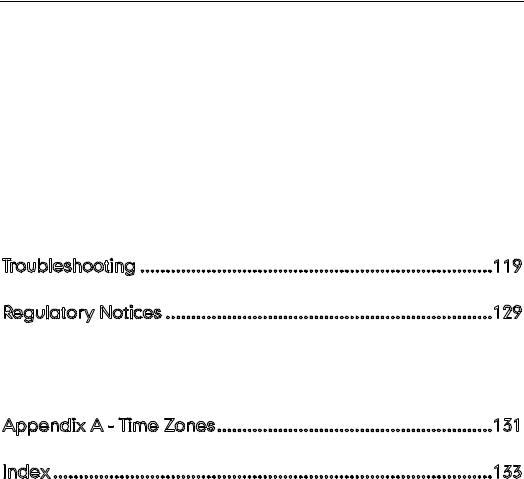
|
Table of Contents |
Outgoing Intercom Calls.............................................................................................. |
103 |
Incoming Intercom Calls .............................................................................................. |
103 |
Multicast Paging............................................................................................................... |
105 |
Sending RTP Stream ..................................................................................................... |
105 |
Receiving RTP Stream................................................................................................... |
107 |
Music on Hold................................................................................................................... |
108 |
Automatic Call Distribution (ACD).................................................................................. |
109 |
Messages.......................................................................................................................... |
111 |
Short Message Service (SMS) .................................................................................... |
111 |
Voice Mail ...................................................................................................................... |
113 |
Message Waiting Indicator (MWI) ............................................................................. |
114 |
Troubleshooting ..................................................................... |
119 |
Regulatory Notices ................................................................ |
129 |
Service Agreements ........................................................................................................ |
129 |
Limitations of Liability ...................................................................................................... |
129 |
Safety Instructions ............................................................................................................ |
129 |
Appendix A - Time Zones...................................................... |
131 |
Index ...................................................................................... |
133 |
ix

User Guide for the SIP-T21P IP Phone
x
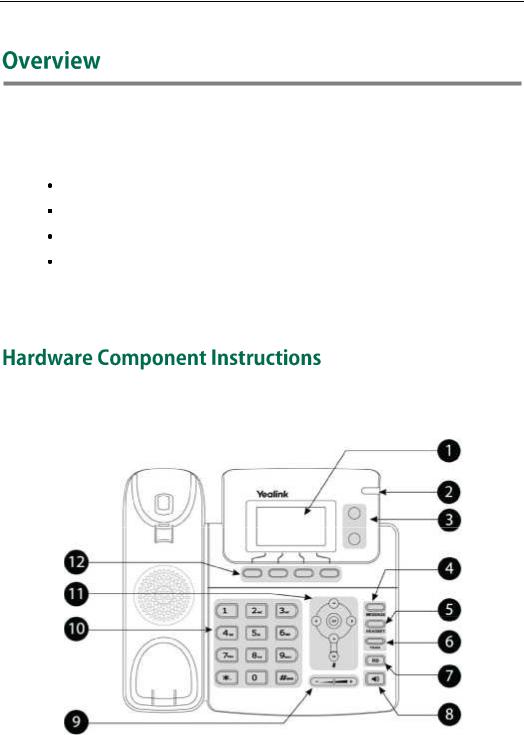
Overview
This chapter provides the overview of the SIP-T21P IP phone. Topics include:  Hardware Component Instructions
Hardware Component Instructions
Icon Instructions
LED Instructions
User Interfaces
Documentations
If you require additional information or assistance with your new phone, contact your system administrator.
The main hardware components of the SIP-T21P IP phone are the LCD screen and the keypad.
1
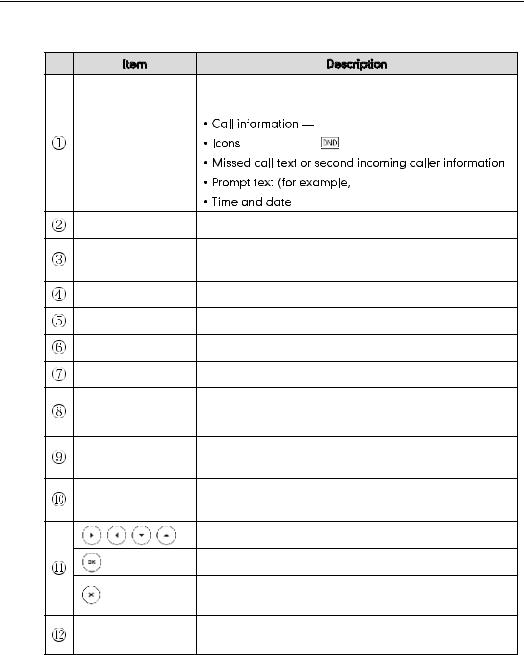
User Guide for the SIP-T21P IP Phone
Hardware component instructions of the SIP-T21P IP phone are:
Item |
|
Description |
|
|
Shows information about calls, messages, soft keys, |
||
|
time, date and other relevant data: |
||
|
caller ID, call duration |
||
LCD Screen |
(for example, |
) |
|
|
|
"Saving config file!") |
|
Power Indicator LED |
Indicates phone power status and phone status. |
||
Line Keys |
Use these keys to activate up to two accounts and assign |
||
various features. |
|
||
|
|
||
MESSAGE Key |
Indicates and accesses voice mails. |
||
HEADSET Key |
Toggles the headset mode. |
||
TRAN Key |
Transfers a call to another party. |
||
RD Key |
Redials a previously dialed number. |
||
Speakerphone Key |
Toggles the hands-free speakerphone mode. |
||
Volume Key |
Adjusts the volume of the handset, headset, speaker, |
||
and ringer. |
|
||
|
|
||
Keypad |
Provides the digits, letters and special characters in |
||
context-sensitive applications. |
|||
|
|||
|
Scroll through the displayed information. |
||
|
Confirms actions or answers incoming calls. |
||
|
Cancels actions, rejects incoming calls, mutes or |
||
|
un-mutes calls. |
|
|
Soft Keys |
Label automatically to identity their context-sensitive |
||
features. |
|
||
|
|
||
2
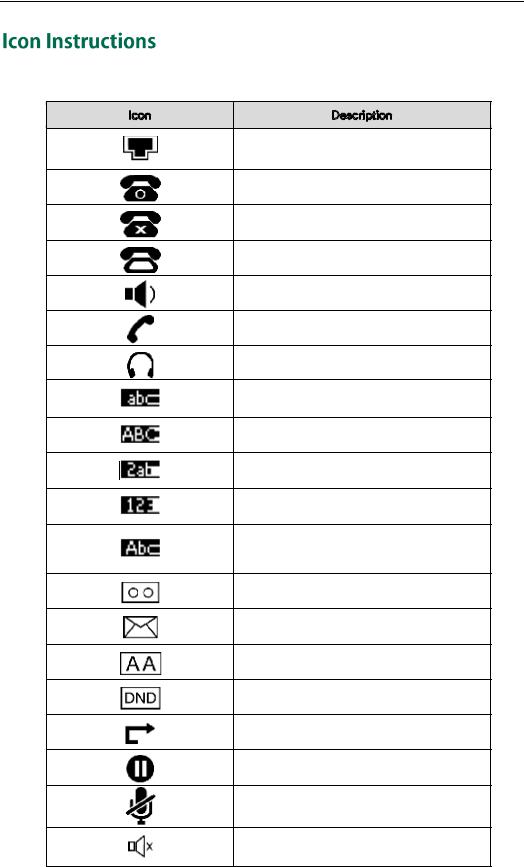
Overview
Icons appearing on the LCD screen are described in the following table:
Icon |
Description |
|
Network is unavailable |
|
Registered successfully |
|
Register failed |
|
Registering |
|
Hands-free speakerphone mode |
|
Handset mode |
|
Headset mode |
|
Multi-lingual lowercase letters input mode |
|
Multi-lingual uppercase letters input mode |
|
Alphanumeric input mode |
|
Numeric input mode |
|
Multi-lingual uppercase and lowercase |
|
letters input mode |
|
Voice Mail |
|
Text Message |
|
Auto Answer |
|
Do Not Disturb |
|
Call Forwarded/Forwarded Calls |
|
Call Hold |
|
Call Mute |
|
Ringer volume is 0 |
3
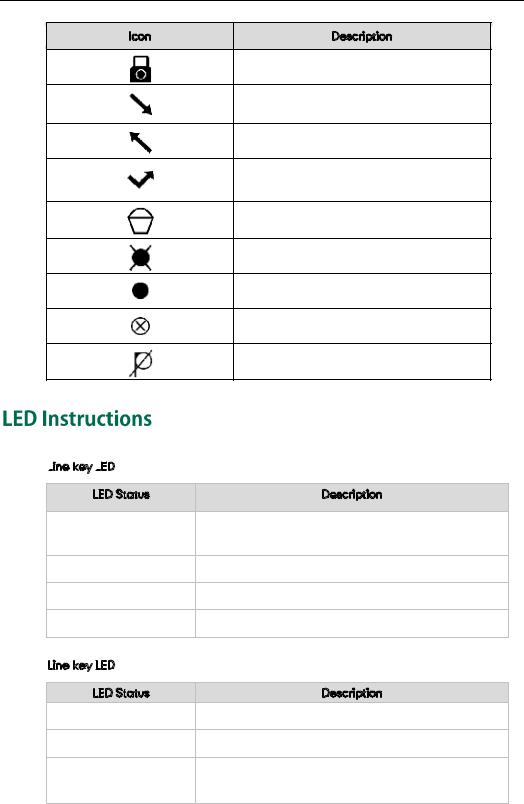
User Guide for the SIP-T21P IP Phone
Icon |
Description |
Keypad Lock
Received Calls
Placed Calls
Missed Calls
Recording box is full
A call cannot be recorded
Recording starts successfully
Recording cannot be started
Recording cannot be stopped
Line key LED
key LED
LED Status |
Description |
|
Solid green |
The line is in conversation. |
|
The line is seized. |
||
|
||
Fast flashing green |
The line receives an incoming call. |
|
Slow flashing green |
The call is placed on hold. |
|
|
||
Off |
The line is inactive. |
|
|
||
Line key LED (configured as BLF key) |
||
LED Status |
Description |
|
Solid green |
The monitored user is busy. |
|
Fast flashing green |
The monitored user receives an incoming call. |
|
Off |
The monitored user is idle. |
|
The monitored user does not exist. |
||
|
||
4
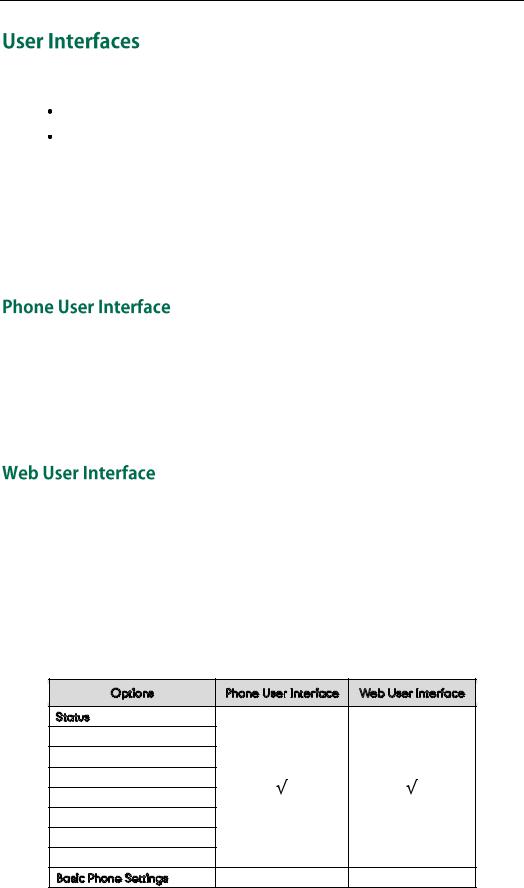
Overview
Two ways to customize configurations of your SIP-T21P IP phone:
The user interface on the IP phone.
The user interface in a web browser on your PC.
The hardware components keypad and LCD screen constitute the phone user interface, which allows the user to execute all call operation tasks and basic configuration changes directly on the phone. In addition, you can use the web user interface to access all configuration settings. In many cases, either the phone user interface and/or the web user interface interchangeably. However, in some cases, it is only possible to use one or the other interface to operate the phone and change settings.
You can customize your phone by pressing the Menu soft key to access the phone user interface. The Advanced Settings option is only accessible to the administrator, and the default administrator password is  admin
admin (case-sensitive). For more information on customizing your phone with the available options from the phone user interface, refer to Customizing Your Phone on page 17.
(case-sensitive). For more information on customizing your phone with the available options from the phone user interface, refer to Customizing Your Phone on page 17.
In addition to the phone user interface, you can also customize your phone via web user interface. In order to access the web user interface, you need to know the IP address of your new phone. To obtain the IP address, press the OK key on the phone. Enter the IP address (e.g., http://192.168.0.10 or 192.168.0.10) in the address bar of web browser on your PC. The default administrator user name and password are both  admin
admin (case-sensitive).
(case-sensitive).
The options you can use to customize the IP phone via phone user interface and/or via web user interface are listed in the following table:
Options |
Phone User Interface |
Web User Interface |
Status |
|
|
--IP Address |
|
|
--IPv6 |
|
|
--MAC |
|
|
--Firmware |
|
|
--Network |
|
|
--Phone |
|
|
--Accounts |
|
|
Basic Phone Settings |
|
|
5
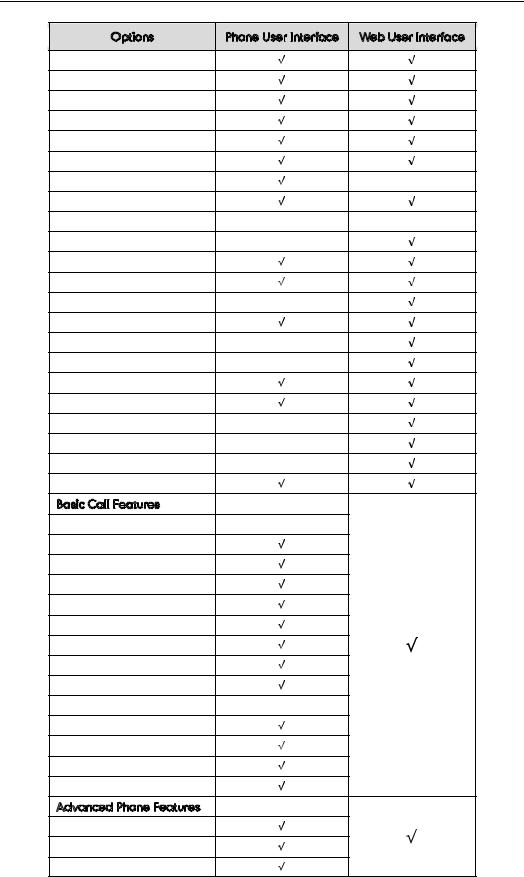
User Guide for the SIP-T21P IP Phone
Options |
Phone User Interface |
Web User Interface |
--Contrast |
|
|
--Language |
|
|
--Time & Date |
|
|
--Administrator Password |
|
|
--Key as Send |
|
|
--Keypad Lock |
|
|
-- Volume |
|
|
--Ring Tones |
|
|
--Contact Management |
|
|
--Directory |
|
|
--Local Directory |
|
|
--Blacklist |
|
|
--Remote Phone Book |
|
|
--Call History Management |
|
|
--Logo Customization |
|
|
--Headset Prior |
|
|
--DSS Keys |
|
|
--Account Registration |
|
|
--Dial Plan |
|
|
--Emergency Number |
|
|
--Live Dialpad |
|
|
--Hotline |
|
|
Basic Call Features |
|
|
--Recent Call In Dialing |
|
|
--Auto Answer |
|
|
--Auto Redial |
|
|
--Call Completion |
|
|
--Call Return |
|
|
--DND |
|
|
--Call Forward |
|
|
--Call Transfer |
|
|
--Call Waiting |
|
|
--Conference |
|
|
--Call Park |
|
|
--Call Pickup |
|
|
--Anonymous Call |
|
|
--Anonymous Call Rejection |
|
|
Advanced Phone Features |
|
|
--BLF |
|
|
--Call Recording |
|
|
--Hot Desking |
|
|
6
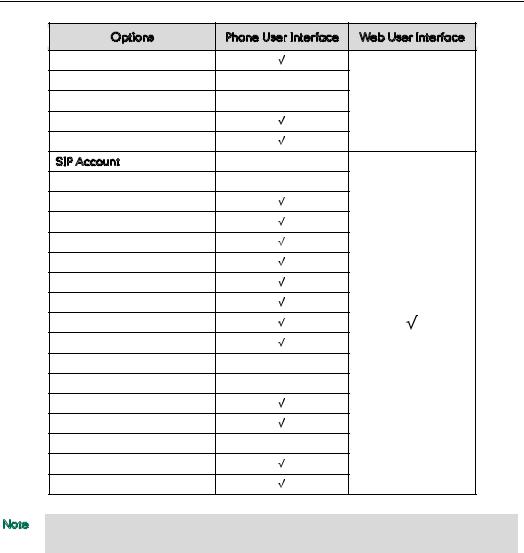
|
|
Overview |
Options |
Phone User Interface |
Web User Interface |
--Intercom |
|
|
--Multicast Paging |
|
|
--Music on Hold |
|
|
--ACD |
|
|
--Messages |
|
|
SIP Account |
|
|
--User Options |
|
|
--Register Status |
|
|
--Activation |
|
|
--Label |
|
|
--Display Name |
|
|
--Register Name |
|
|
--User Name |
|
|
--Password |
|
|
--SIP Server1/2 |
|
|
--Server Option |
|
|
--Server Port |
|
|
--Outbound Status |
|
|
--Outbound Proxy |
|
|
--NAT Traversal |
|
|
--STUN Status |
|
|
--STUN Server |
|
|
Note |
The table above lists most of the feature options. Please refer to the relevant sections for |
|
more information. |
7
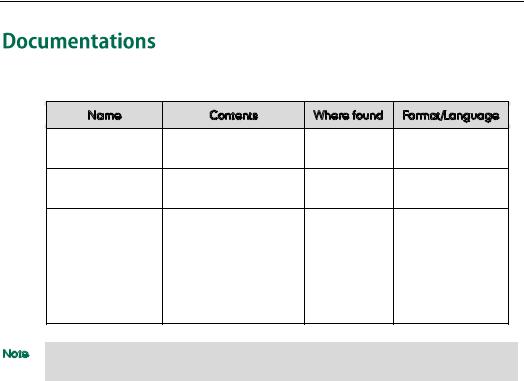
User Guide for the SIP-T21P IP Phone
The following table shows documentations available for the SIP-T21P IP phone.
Name |
Contents |
Where found |
Format/Language |
|
Quick Installation |
Basic setup of the |
In the |
PDF/English |
|
Guide |
phone |
package |
||
|
||||
Quick Reference |
Basic call features and |
In the |
PDF/English |
|
Guide |
phone customizations |
package |
||
|
||||
|
Phone/Web user |
|
|
|
|
interface settings |
CD attached |
|
|
User Guide |
Basic call features and |
in the |
PDF/English |
|
|
advanced phone |
package |
|
|
|
features |
|
|
Note You can also download the latest documentations online: http://www.yealink.com/DocumentDownload.aspx?CateId=142&flag=142.
8
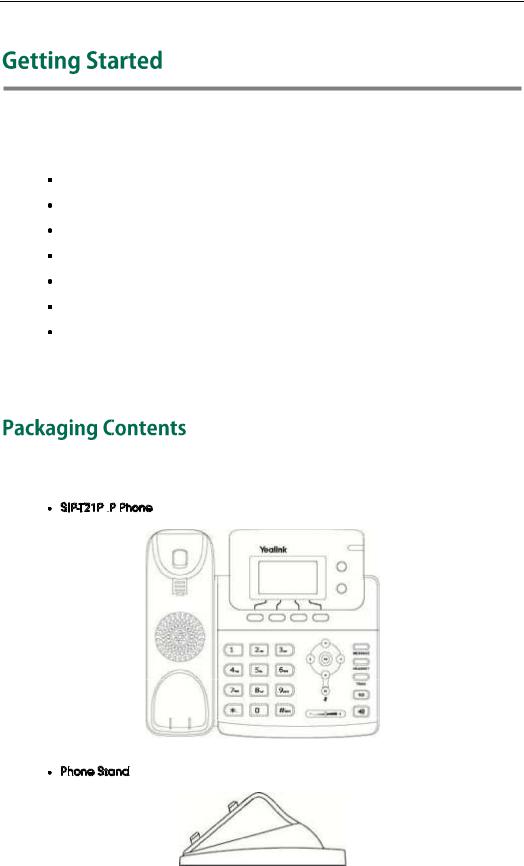
Getting Started
This chapter provides basic installation instructions and information for obtaining the best performance with the SIP-T21P IP phone. Topics include:
Packaging Contents
Phone Installation
Phone Initialization
Phone Status
Basic Network Settings
Registration
Idle Screen
If you require additional information or assistance with your new phone, contact your system administrator.
The following components are included in your SIP-T21P IP phone package:
SIP-
 T21P IP
T21P IP Phone
Phone
Phone Stand
9
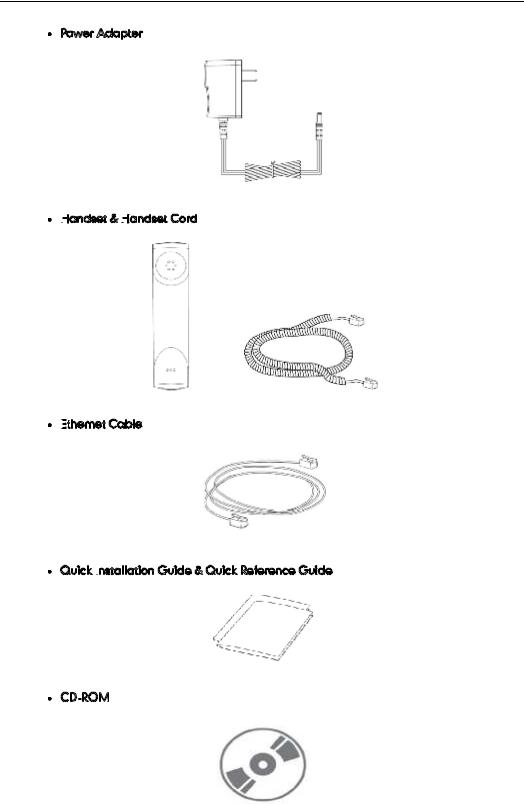
User Guide for the SIP-T21P IP Phone
Power Adapter
Handset & Handset
& Handset Cord
Cord
Ethernet
 Cable
Cable
Quick Installation Guide & Quick Reference Guide
Guide & Quick Reference Guide
CD-ROM
Check the list before installation. If you find anything missing, contact your system administrator.
10
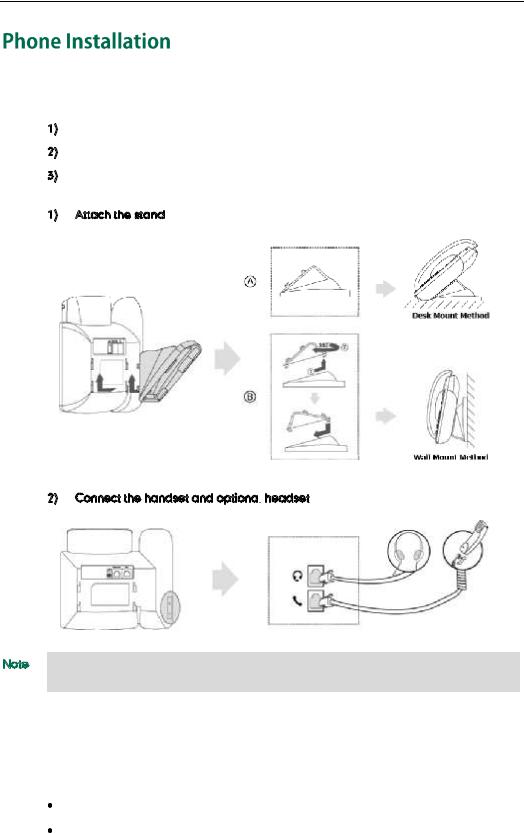
Getting Started
If your phone is already installed, proceed to Phone Initialization on page 13. This section introduces how to install the phone:
1)Attach the stand
2)Connect the handset and optional headset
3)Connect the network and power
1)Attach the stand
2)Connect the handset and optional headset
headset
Note A headset is not included in the packaging contents. Contact your system administrator for more information.
3)Connect the network and power
You have two options for power and network connections. Your system administrator will advise you which one to use.
AC power
Power over Ethernet (PoE)
11
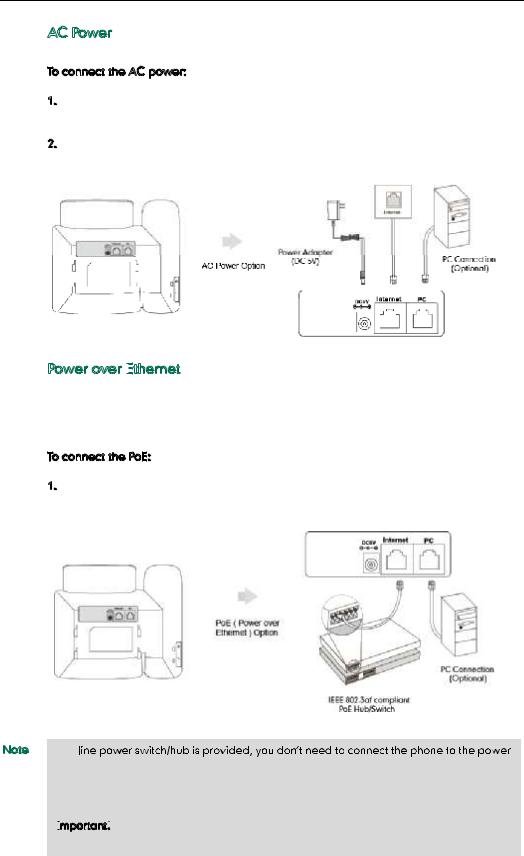
User Guide for the SIP-T21P IP Phone
AC Power
To connect the AC power:
1.Connect the DC plug on the power adapter to the DC5V port on the phone and connect the other end of the power adapter into an electrical power outlet.
2.Connect the included or a standard Ethernet cable between the Internet port on the phone and the one on the wall or switch/hub device port.
Power over Ethernet

With the included or a regular Ethernet cable, the SIP-T21P IP phone can be powered from a PoE-compliant switch or hub.
To connect the PoE:
1.Connect the Ethernet cable between the Internet port on the phone and an available port on the in-line power switch/hub.
Note |
If in- |
|
adapter. Make sure the switch/hub is PoE-compliant. |
The phone can also share the network with another network device such as a PC (personal computer). It is an optional connection.
Important!


 Do not unplug or remove power to the phone while it is updating firmware and configurations.
Do not unplug or remove power to the phone while it is updating firmware and configurations.
12
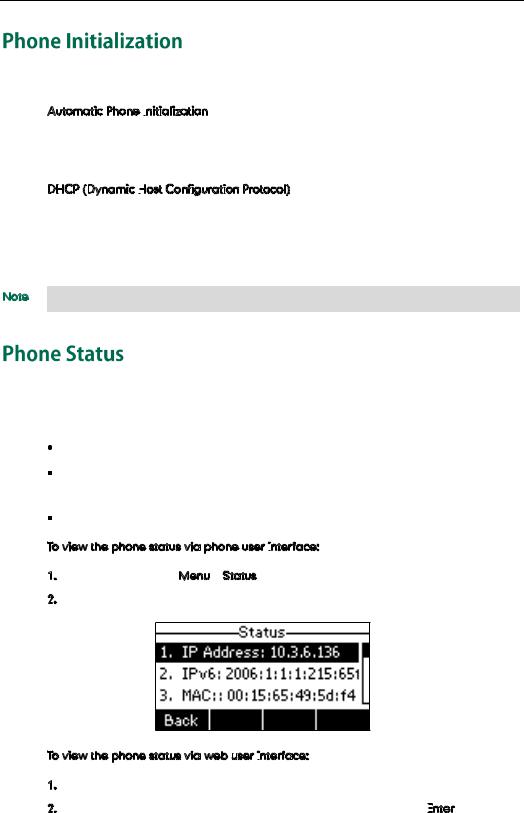
Getting Started
After your phone is powered on, the system boots up and performs the following steps:
Automatic Phone Initialization
The phone finishes the initialization by loading the saved configuration. The LCD screen 













 p
p














DHCP (Dynamic Host Configuration Protocol)
Configuration Protocol)
The phone attempts to contact a DHCP server in your network to obtain valid IPv4 and IPv6 network settings (e.g., IP address, subnet mask, default gateway address and DNS address) by default.
Note If your network does not use DHCP, proceed to Basic Network Settings on page 14.
You can view phone status via phone user interface or web user interface.
Available information of phone status includes:
Network status (e.g., IPv4 status, IPv6 status, IP mode and MAC address).
Phone status (e.g., device model, hardware version, firmware version, product ID, MAC address and device certificate status: factory, installed and not installed).
Account status (e.g., the register status of SIP accounts).
To view the phone status via phone user interface:
1.Press  , or press Menu->Status.
, or press Menu->Status.
2.Press  or
or  to scroll through the list and view the specific information.
to scroll through the list and view the specific information.
To view the phone status via web user interface:
1.Open the web browser of your computer.
2.Enter the IP addres













 , and then press Enter.
, and then press Enter.

13
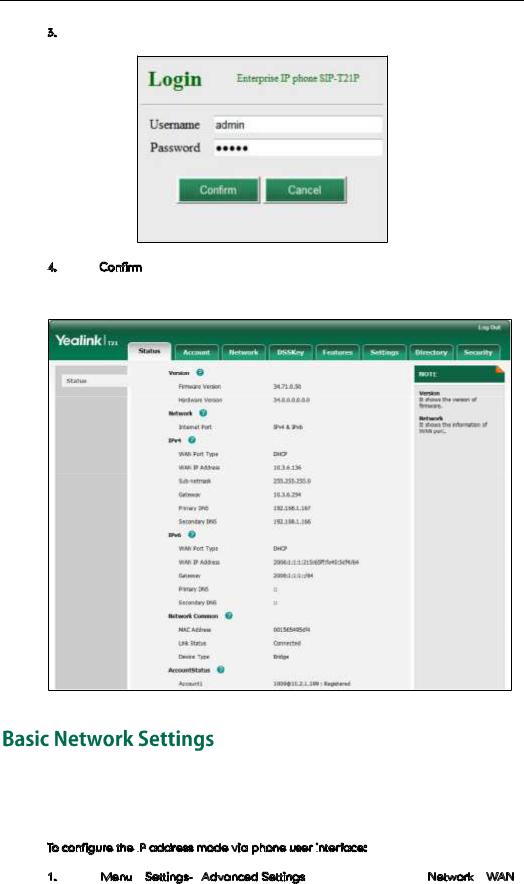
User Guide for the SIP-T21P IP Phone
3.Enter the user name (admin) and password (admin) in the login page.
4.Click Confirm to login.
The phone status is displayed on the first page of the web user interface.
If your phone cannot contact a DHCP server for any reason, you need to configure network settings manually. The IP phone can support either or both IPv4 and IPv6 addresses.
To configure the IP address mode via phone user interface:
address mode via phone user interface:
1.Press Menu->Settings->Advanced Settings (password: admin) ->Network->WAN
14
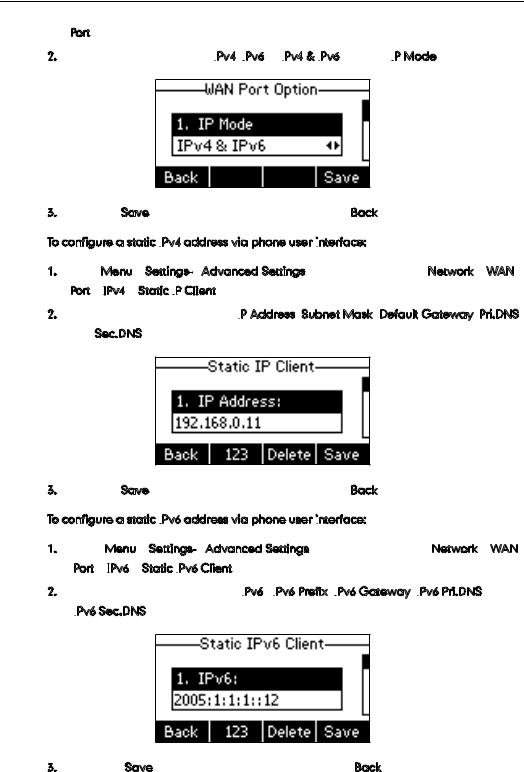
Getting Started
Port.
2.Press  or
or  to select IPv4,
to select IPv4,
 IPv6
IPv6
 or IPv4
or IPv4
 & IPv6
& IPv6
 from the IP
from the IP
 Mode field.
Mode field.
3. Press the Save soft key to accept the change or the Back soft key to cancel.
To configure a static IPv4 address via phone user interface:
address via phone user interface:
1.Press Menu->Settings->Advanced Settings (password: admin) ->Network->WAN Port->IPv4->Static IP
 Client.
Client.
2.Enter the desired values in the IP
 Address, Subnet Mask, Default Gateway, Pri.DNS and Sec.DNS fields respectively.
Address, Subnet Mask, Default Gateway, Pri.DNS and Sec.DNS fields respectively.
3. Press the Save soft key to accept the change or the Back soft key to cancel.
To configure a static IPv6 address via phone user interface:
address via phone user interface:
1.Press Menu->Settings->Advanced Settings (password: admin) ->Network->WAN Port->IPv6->Static IPv6
 Client.
Client.
2.Enter the desired values in the IPv6
 , IPv6
, IPv6
 Prefix, IPv6
Prefix, IPv6
 Gateway, IPv6
Gateway, IPv6
 Pri.DNS and IPv6
Pri.DNS and IPv6
 Sec.DNS fields respectively.
Sec.DNS fields respectively.
3.Press the Save soft key to accept the change or the Back soft key to cancel.
If you are using an xDSL modem for IPv4 network connection, you can connect your phone to the Internet via PPPoE mode. Set the WAN port as a PPPoE port. The PPPoE port will perform a PPP negotiation to obtain the IP address. Contact your system administrator for the PPPoE user name and password.
15
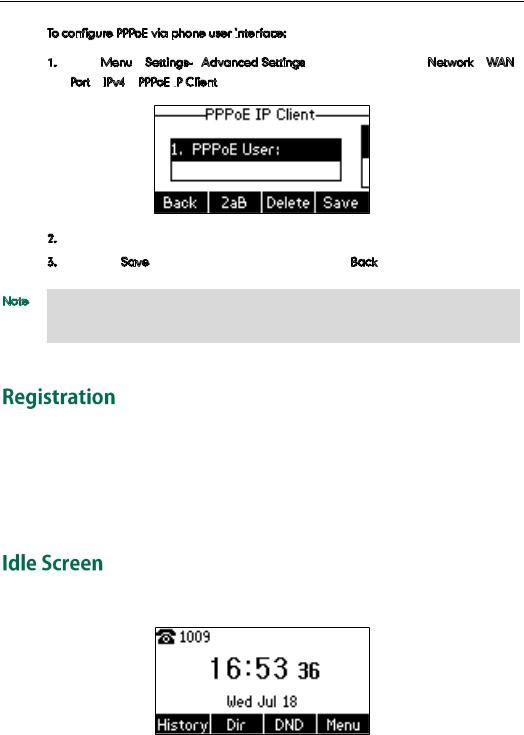
User Guide for the SIP-T21P IP Phone
To configure PPPoE via phone user interface:
via phone user interface:
1.Press Menu->Settings->Advanced Settings (password: admin) ->Network->WAN Port->IPv4->PPPoE IP
IP
 Client.
Client.
2.Enter the user name and password in the corresponding fields.
3.Press the Save soft key to accept the change or the Back soft key to cancel.
Note Using the wrong network parameters may result in inaccessibility of your phone and may also have an impact on your network performance. For more information on these parameters, contact your system administrator.
Generally, your phone will be deployed with multiple other phones. In this case, your system administrator will configure the phone parameters beforehand, so that after you start up your phone, the phone will be registered and ready for use. If your phone is not registered, you may have to register it. For more information on how to register your phone, refer to Account Management on page 54.
If the phone has successfully started up, the idle screen will be shown as below:
The idle screen shows the label of current account, time and date, and four soft keys.
16

Customizing Your Phone
You can customize your SIP-T21P IP phone by personally configuring certain settings, for example, contrast, language and time & date. 















 local directory manually or from call history. You can also personalize different ring tones for different callers.
local directory manually or from call history. You can also personalize different ring tones for different callers.
This chapter provides basic operating instructions for customizing your phone. Topics include:
General Settings
Audio Settings
Contact Management
Call History Management
System Customizations
If you require additional information or assistance with your new phone, contact your system administrator.
You can configure the contrast of the LCD screen to a comfortable level.
To configure the contrast via phone user interface:
1.Press Menu->Settings->Basic Setting->Contrast.
2.Press  or
or  , or the Switch soft key to increase or decrease the intensity of contrast.
, or the Switch soft key to increase or decrease the intensity of contrast.
The default contrast level is 6.
3. Press the Save soft key to accept the change or the Back soft key to cancel. Contrast is configurable via web user interface at the path Settings->Preference.
17
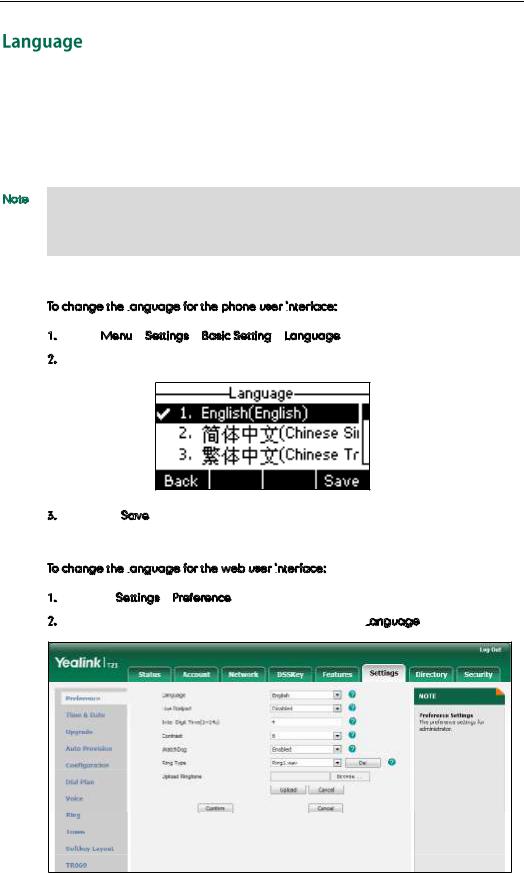
User Guide for the SIP-T21P IP Phone
The default language of the phone user interface is English. The phone will detect and use the same language as which of your web browser for the web user interface. If the language of your web browser is not supported by the phone, the web user interface will use English. You can change the language for the phone user interface and the web user interface respectively.
Note Not all of the supported languages are available for selection. The available languages depend on the language packs currently loaded to the IP phone. Please contact your system administrator for more information on the available languages of your new phone.
To change the language for the phone user interface:
for the phone user interface:
1.Press Menu->Settings->Basic Setting->Language.
2.Press  or
or  to select the desired language.
to select the desired language.
3.Press the Save soft key to accept the change.
Text displayed on the LCD screen will change to the selected language.
To change the language for the web user interface:
for the web user interface:
1.Click on Settings->Preference.
2.Select the desired language from the pull-down list of Language.
18
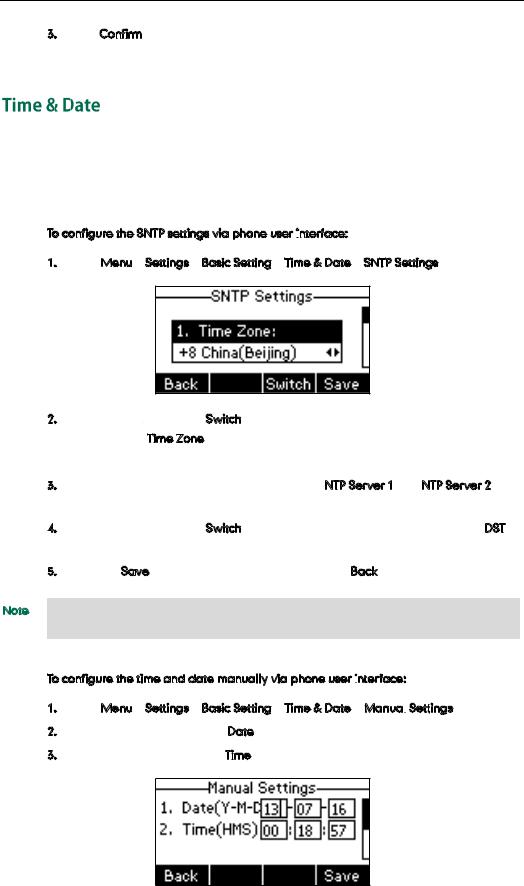
Customizing Your Phone
3.Click Confirm to accept the change.
Text displayed on the web user interface will change to the selected language.
The time and date are displayed on the LCD screen when the phone is idle. If the phone cannot obtain the time and date from the Simple Network Time Protocol (SNTP) server, you need to configure the time and date manually. For more information on the SNTP server, contact your system administrator.
To configure the SNTP settings via phone user interface:
1.Press Menu->Settings->Basic Setting->Time & Date->SNTP Settings.
2.Press  or
or  , or the Switch soft key to select the time zone that applies to your area from the Time Zone field.
, or the Switch soft key to select the time zone that applies to your area from the Time Zone field.
The default time zone is "+8 China(Beijing)".
3.Enter the domain names or IP addresses in the NTP Server 1 and NTP Server 2 fields respectively.
4.Press  or
or  , or the Switch soft key to select the desired value from the DST field.
, or the Switch soft key to select the desired value from the DST field.
5.Press the Save soft key to accept the change or the Back soft key to cancel.
Note Please refer to Appendix A - Time Zones for the list of available time zones on the IP phone.
To configure the time and date manually via phone user interface:
1.Press Menu->Settings->Basic Setting->Time & Date->Manual
 Settings.
Settings.
2.Enter the specific date in the Date field.
3.Enter the specific time in the Time field.
19
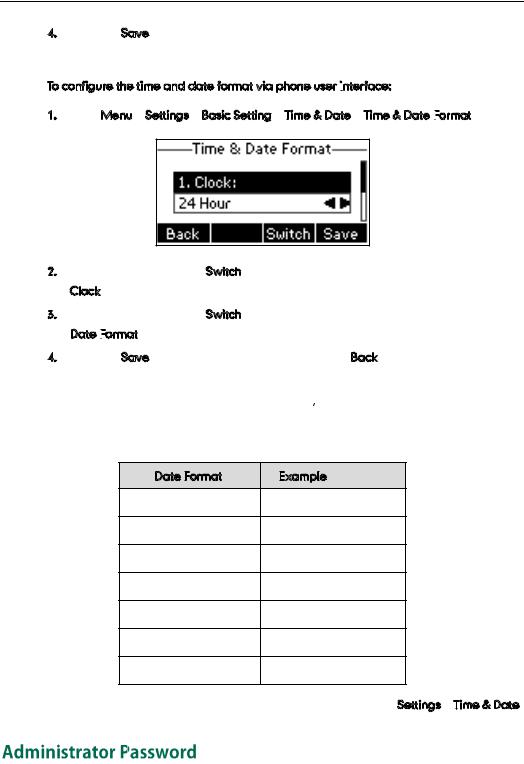
User Guide for the SIP-T21P IP Phone
4.Press the Save soft key to accept the change.
The date and time displayed on the LCD screen will change accordingly.
To configure the time and date format via phone user interface:
1.Press Menu->Settings->Basic Setting->Time & Date->Time & Date Format.

2.Press  or
or  , or the Switch soft key to select the desired time format from the Clock field.
, or the Switch soft key to select the desired time format from the Clock field.
3.Press  or
or  , or the Switch soft key to select the desired date format from the Date Format
, or the Switch soft key to select the desired date format from the Date Format
 field.
field.
4.Press the Save soft key to accept the change or the Back soft key to cancel.
There are 7 available date formats. For example, for 






 WWW DD MMM
WWW DD MMM ,
,  WWW
WWW represents the abbreviation of the week
represents the abbreviation of the week  DD
DD




 s the two-digit day,
s the two-digit day,


 MMM
MMM




 s the first three letters of the month. The date formats you need to know:
s the first three letters of the month. The date formats you need to know:
Date Format |
Example(2013-1-16) |
WWW MMM DD |
Wed Jan 16 |
DD-MMM-YY |
16-Jan-13 |
YYYY-MM-DD |
2013-01-16 |
DD/MM/YYYY |
16/01/2013 |
MM/DD/YY |
01/16/13 |
DD MMM YYYY |
16 Jan 2013 |
WWW DD MMM |
Wed 16 Jan |
Time and date is configurable via web user interface at the path Settings->Time & Date.
The Advanced Settings option is only accessible to the administrator. The default administrator password is  admin
admin . For security reasons, you should change the default administrator password as soon as possible.
. For security reasons, you should change the default administrator password as soon as possible.
20
